A new study, entitled “Perverse policy incentives and inferior economic outcomes” has exposed the failings of Australia’s migration system, particularly the student visa system.
The study’s abstract is presented below:
Between 1999 and 2012, Australia enacted a raft of policies that advantaged overseas students when applying for permanent residency, through the so-called 880 visa series. These policies greatly enhanced prospective students’ prospects to secure permanent residency when pursuing specific qualifications.
Leveraging rich longitudinal administrative data linked to the universe of permanent visas issued in Australia, we analyse the economic implications of these historically skewed policy incentives. We document significant negative migrant selection.
880 migrants attracted lower incomes and exhibited lower probabilities of employment in high-skilled occupations, when compared to both migrants educated overseas as well as domestic students.
880 migrants achieved superior aggregate employment outcomes, however, particularly in lower-skilled occupations unrelated to their fields of study.
If visa streams are poorly designed, therefore, any potential benefits of onshore education risk being crowded out by negative migrant selection.
Various other recent studies have replicated these findings.
The latest study on the international education sector by Jobs & Skills Australia (JSA) openly acknowledged that most international students come to Australia primarily to work and live, rather than for educational purposes. Nearly 70% of international higher education students reported migration as a reason for choosing to study in Australia, JSA found.
JSA confirmed that international graduates earn significantly less than domestic graduates and work in lower-skilled jobs:

“International graduates remaining in Australia after their study are less likely to secure employment in their field and at their qualification level and earn less than domestic counterparts”, JSA wrote. “These effects are more exaggerated for higher education graduates than VET graduates”.

“Many higher education graduates remain employed in sectors that may have minimal long term benefit to employability in their field of qualification (e.g. Retail Trade). While Accountants and Registered Nurses are the most common occupation for Temporary Graduate visa holders, some of the most common jobs held by these graduates are at Skill Level 3, 4 or 5”.
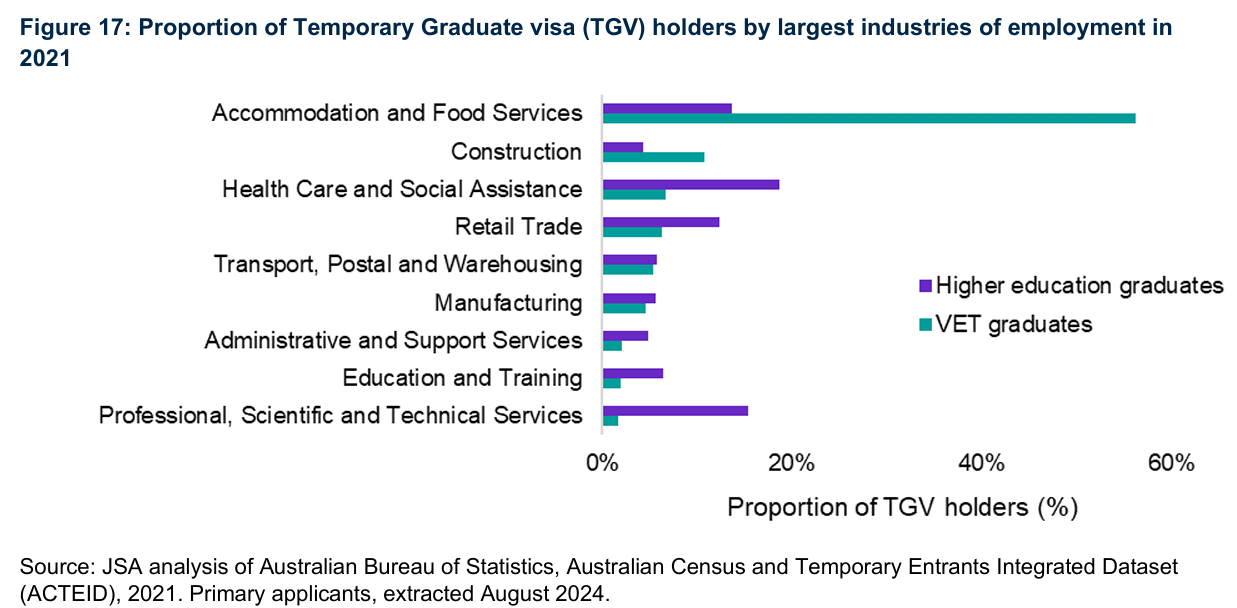
“A Department of Education analysis in 2022 found growing numbers of higher education graduates were employed in occupations such as sales assistants and call centre operators in line with growth in Temporary Graduate visas granted (Figure 18)”.
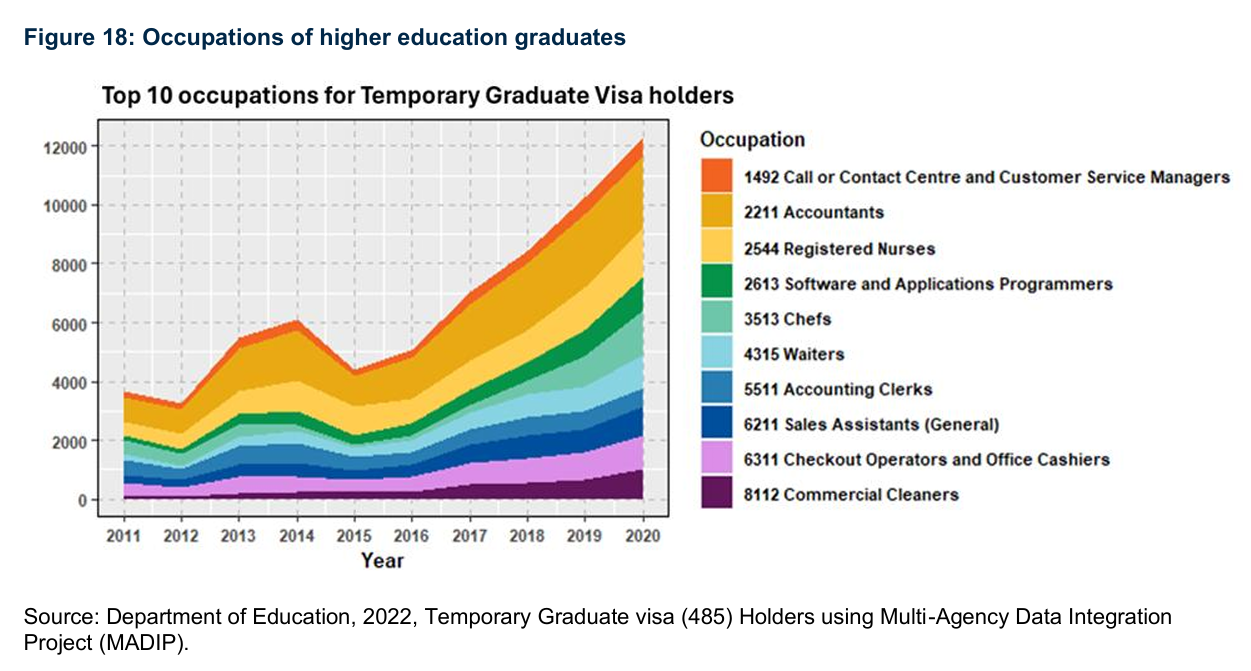
JSA showed that international graduates who studied the most popular university degree of business and management earned roughly half as much as domestic graduates with the same qualification—$56,900 compared to $115,000 for local graduates.
For engineering and computing graduates, internationals earned $60,000 compared to $100,000 for domestic graduates—a sign they had found jobs in different fields.
JSA cited an engineering employer who said a foreign graduate told him “a lot of his mates just come here to earn the money, drive the Uber’’.
A recent report from the Australian National University found that just 12% of places in the nation’s permanent migration program are going to “genuinely new skilled arrivals from offshore”. Instead, many of these places are being allocated to members of skilled workers’ families.
The report came from pro-Big Australia shills Peter McDonald and Alan Gamlen, who admitted that Australia’s immigration system is broken:
“Australia’s migration programme has failed to deliver what it promises”, the authors said in their report.
“It brings in relatively few genuinely skilled workers, while favouring family migration”.
“It delivers few new skilled workers while being clogged with family visas that, by law, should not be capped at all”.
“The permanent intake is capped at 185,000 people per year, of which around 30% is earmarked for family visas. Even within the Skilled Stream, the majority of visas do not go to skilled workers but to their families”.
“Counting family and secondary applicants together, more than 60% of permanent visas are, in fact, family-related. Double the amount officially claimed”.
“Meanwhile, the share of genuinely new skilled arrivals from offshore is tiny, just 12% of the programme. The rest are already in Australia on temporary visas”, they say.
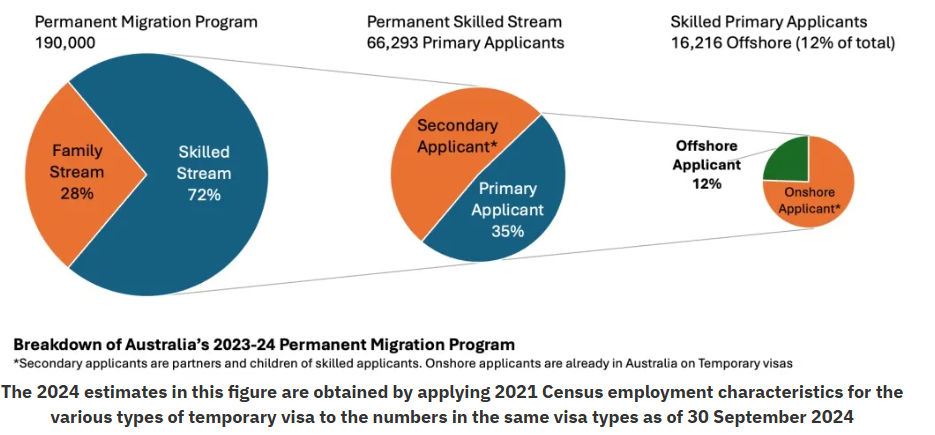
The authors should also have mentioned that Australia imports 20,000 unskilled humanitarian migrants every year, adding to the skills problem.
The following chart from the Grattan Institute shows similar outcomes:

These unskilled migrants also have poor labour market outcomes, according to the Australian Treasury:

The Committee for Economic Development of Australia (CEDA) also studied the most recent census and discovered that Australia’s ‘skilled’ migrants are routinely underemployed and underpaid.
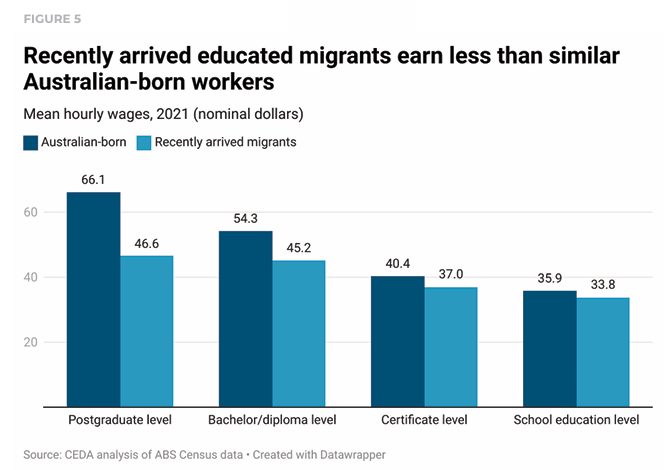
“Recent migrants earn significantly less than Australian-born workers, and this has worsened over time”, CEDA senior economist Andrew Barker said.
“This decade, migrants have become increasingly likely to work in lower productivity firms”.
In a similar vein, the federal government’s 2023 Migration Review found that 51% of overseas-born university graduates with bachelor’s degrees were employed in unskilled jobs three years after graduation.
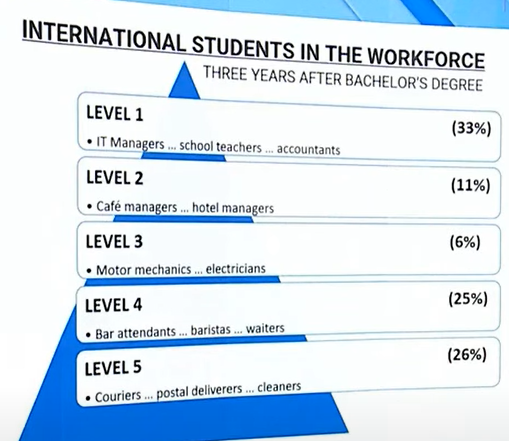
Source: Migration Review, 2023.
Moreover, according to the Graduate Outcomes Survey, international graduates earn significantly less than domestic graduates and have inferior labour market outcomes.
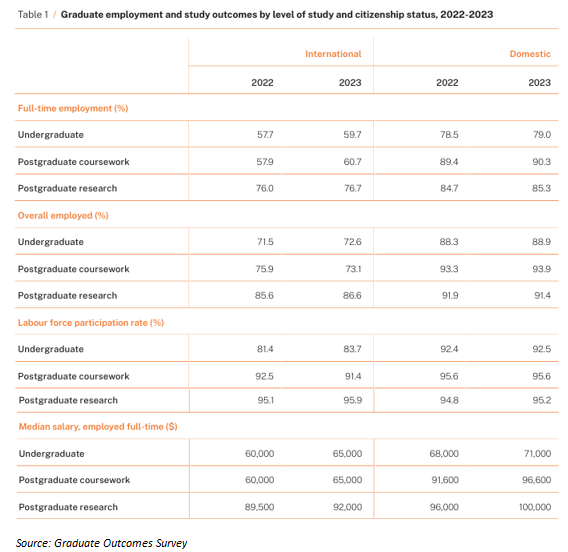
When will Australia’s policymakers admit that the immigration system has failed and has crush-loaded the nation with low-skilled, low-productivity migrants in the wrong skill areas?
The obvious solution is to run a significantly smaller program that prioritises quality over quantity?
The wage floor for all skilled visas should be set at a higher level than the current median full-time salary of around $90,000. All skilled visas should be employer-sponsored, with eligible migrants required to work in their field of expertise straight away. Only primary skilled applicants should be prioritised.
All retirement visas, including parental and ‘golden’ ticket visas, must be abolished.
Entry standards and financial requirements for other temporary visas, such as student visas, should be significantly tightened to prioritise quality over quantity. Only exceptional overseas students should be granted post-study graduate visas.
Unfortunately, the Albanese government has chosen the opposite strategy, increasing the planning level for international students by 25,000 for 2026 while loosening English-language proficiency requirements, lowering risk assessments for South Asian students, and increasing the number of tertiary institutions with the lowest risk ratings for visas by around 15.
As a result, the quality of Australia’s migration system will erode further, resulting in endemic skills shortages, poor productivity growth, and crush-loaded living standards.

